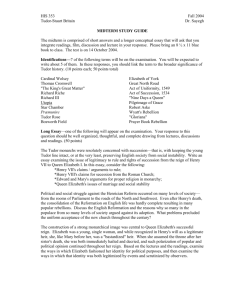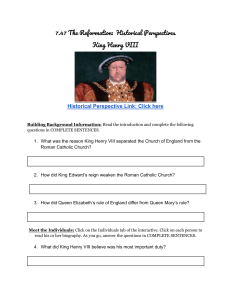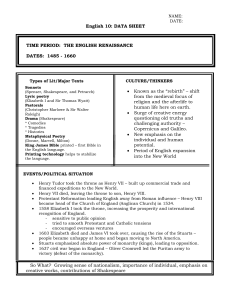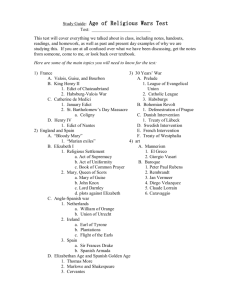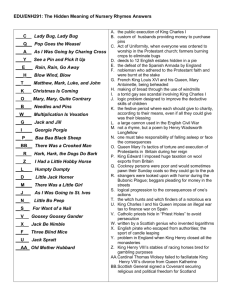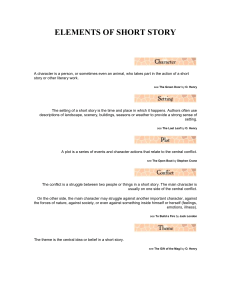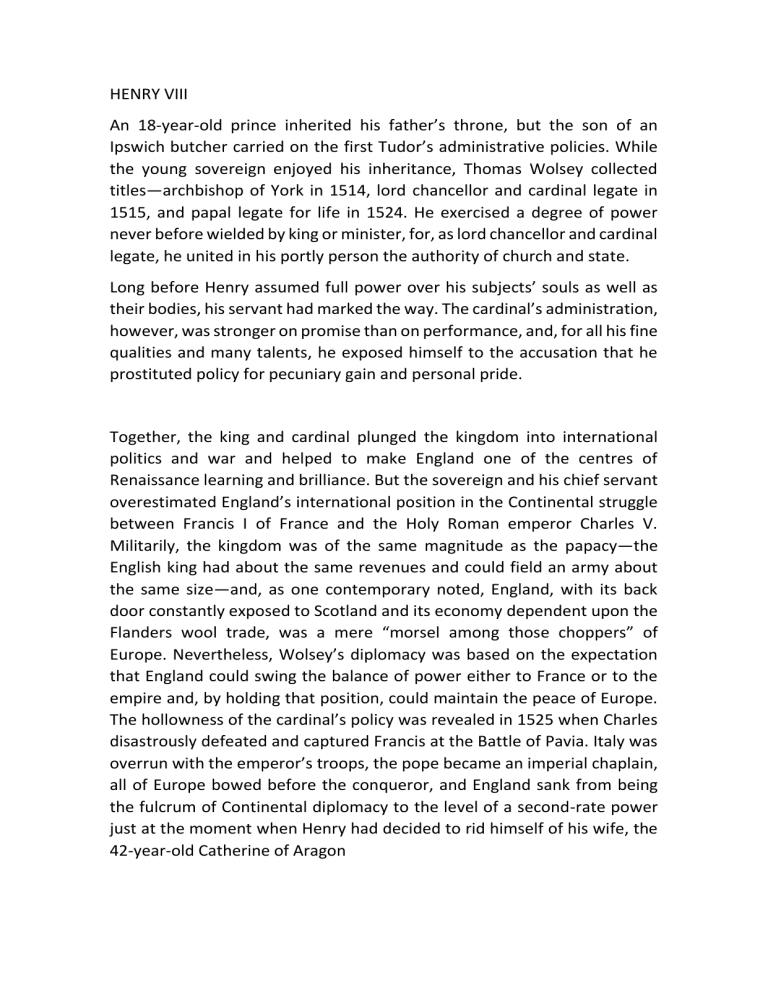
HENRY VIII An 18-year-old prince inherited his father’s throne, but the son of an Ipswich butcher carried on the first Tudor’s administrative policies. While the young sovereign enjoyed his inheritance, Thomas Wolsey collected titles—archbishop of York in 1514, lord chancellor and cardinal legate in 1515, and papal legate for life in 1524. He exercised a degree of power never before wielded by king or minister, for, as lord chancellor and cardinal legate, he united in his portly person the authority of church and state. Long before Henry assumed full power over his subjects’ souls as well as their bodies, his servant had marked the way. The cardinal’s administration, however, was stronger on promise than on performance, and, for all his fine qualities and many talents, he exposed himself to the accusation that he prostituted policy for pecuniary gain and personal pride. Together, the king and cardinal plunged the kingdom into international politics and war and helped to make England one of the centres of Renaissance learning and brilliance. But the sovereign and his chief servant overestimated England’s international position in the Continental struggle between Francis I of France and the Holy Roman emperor Charles V. Militarily, the kingdom was of the same magnitude as the papacy—the English king had about the same revenues and could field an army about the same size—and, as one contemporary noted, England, with its back door constantly exposed to Scotland and its economy dependent upon the Flanders wool trade, was a mere “morsel among those choppers” of Europe. Nevertheless, Wolsey’s diplomacy was based on the expectation that England could swing the balance of power either to France or to the empire and, by holding that position, could maintain the peace of Europe. The hollowness of the cardinal’s policy was revealed in 1525 when Charles disastrously defeated and captured Francis at the Battle of Pavia. Italy was overrun with the emperor’s troops, the pope became an imperial chaplain, all of Europe bowed before the conqueror, and England sank from being the fulcrum of Continental diplomacy to the level of a second-rate power just at the moment when Henry had decided to rid himself of his wife, the 42-year-old Catherine of Aragon It is still a subject of debate whether Henry’s decision to seek an annulment of his marriage and wed Anne Boleyn was a matter of state, of love, or of conscience; quite possibly all three operated. Catherine was fat, seven years her husband’s senior, and incapable of bearing further children. Anne was everything that the queen was not—pretty, vivacious, and fruitful. Catherine had produced only one child that lived past infancy, a girl, Princess Mary (later Mary I); it seemed ironic indeed that the first Tudor should have solved the question of the succession only to expose the kingdom to what was perceived as an even greater peril in the second generation: a female ruler. The need for a male heir was paramount, for the last queen of England Finally, there was the question of the king’s conscience. Henry had married his brother’s widow, and, though the pope had granted a dispensation, the fact of the matter remained that every male child born to Henry and Catherine had died, proof of what was clearly written in the Bible: “If a man takes his brother’s wife, it is impurity; he has uncovered his brother’s nakedness; they shall be childless” (Leviticus 20:21). Unfortunately, Henry’s annulment was not destined to stand or fall upon the theological issue of whether a papal dispensation could set aside such a prohibition, for Catherine was not simply the king’s wife; she was also the aunt of the emperor Charles V, the most powerful sovereign in Europe. Both Henry and his cardinal knew that the annulment would never be granted unless the emperor’s power in Italy could be overthrown by an AngloFrench military alliance and the pope rescued from imperial domination, and for three years Wolsey worked desperately to achieve this diplomatic and military end. Caught between an all-powerful emperor and a truculent English king, Pope Clement VII procrastinated and offered all sorts of doubtful solutions short of annulment, Wolsey’s policies were a failure, and he was dismissed from office in October 1529. He died on November 29, just in time to escape trial for treason. The Reformation The religious life of the people was especially vibrant in the early decades of the 16th century, and, although there were numerous vociferous critics of clerical standards and behaviour, the institutional church was generally in good heart. And now it was not just great landowners but the people in general who poured money into their churches. Perhaps one in three parish churches underwent major refurbishments in this period. Hundreds of elaborate chantry chapels and altars were erected, money invested in parish guilds doubled (for the benefit of the living in the form of pensions and doles and for the benefit of the dead in the form of masses), and the number of those seeking ordination reached a new peak. There is also some evidence that the monastic life and the endowment of monasteries were slowing down, but in essence the church was successfully meeting the spiritual needs of huge numbers of people. But in 1532, when Henry VIII began to contemplate a schism from Rome, embracing Protestantism was the last thing on his mind, and very few of his subjects would have wished him to do so. The break with Rome With Wolsey and his papal authority gone, Henry turned to the authority of the state to obtain his annulment. The so-called Reformation Parliament that first met in November 1529 was unprecedented; it lasted seven years, enacted 137 statutes (32 of which were of vital importance), and legislated in areas that no medieval Parliament had ever dreamed of entering. “King in Parliament” became the revolutionary instrument by which the medieval church was destroyed. But in 1532, when Henry VIII began to contemplate a schism from Rome, embracing Protestantism was the last thing on his mind, and very few of his subjects would have wished him to do so. On June 1 Anne was crowned rightful queen of England, and three months and a week later, on September 7, 1533, the royal child was born. To “the great shame and confusion” of astrologers, it turned out to be Elizabeth Tudor (later Elizabeth I). Henry was mortified; he had risked his soul and his crown for yet another girl. But Anne had proved her fertility, and it was hoped that a male heir would shortly follow. In the meantime it was necessary to complete the break with Rome and rebuild the Church of England. By the Act of Succession of March 1534, subjects were ordered to accept the king’s marriage to Anne as “undoubted, true, sincere and perfect.” A second Statute “in Restraint of Annates” severed most of the financial ties with Rome, and in November the constitutional revolution was solemnized in the Act of Supremacy, which announced that Henry Tudor was and always had been “Supreme Head of the Church of England”; not even the qualifying phrase “as far as the law of Christ allows” was retained. The consolidation of the Reformation The medieval tenet that church and state were separate entities with divine law standing higher than human law had been legislated out of existence; the new English church was in effect a department of the Tudor state. The destruction of the Roman Catholic Church led inevitably to the dissolution of the monasteries. As monastic religious fervour and economic resources had already begun to dry up, it was easy enough for the government to build a case that monasteries were centres of vice and corruption. In the end, however, what destroyed them was neither apathy nor abuse but the fact that they were contradictions within a national church, for religious foundations by definition were international, supranational organizations that traditionally supported papal authority. Henry’s last years Henry was so securely seated upon his throne that the French ambassador announced that he was more an idol to be worshipped than a king to be obeyed. The king successfully survived four more matrimonial experiments, the enmity of every major power in Europe, and an international war. On May 19, 1536, Anne Boleyn’s career was terminated by the executioner’s ax. She had failed in her promise to produce further children to secure the succession. Her enemies poisoned the king’s mind against her with accusations of multiple adulteries. The king’s love turned to hatred, but what sealed the queen’s fate was probably the death of her rival, Catherine of Aragon, on January 8, 1536. From that moment it was clear that, should Henry again marry, whoever was his wife, the children she might bear would be legitimate in the eyes of Roman Catholics and Protestants alike. How much policy, how much revulsion for Anne, and how much attraction for Jane Seymour played in the final tragedy is beyond analysis, but 11 days after Anne’s execution Henry married Jane. Sixteen months later the future Edward VI was born. Jane died as a consequence, but Henry finally had what it had taken a revolution to achieve—a legitimate male heir. Henry married thrice more, once for reasons of diplomacy, once for love, and once for peace and quiet. Anne of Cleves, his fourth wife, was the product of Reformation international politics. For a time in 1539 it looked as if Charles V and Francis would come to terms and unite against the schismatic king of England, and the only allies Henry possessed were the Lutheran princes of Germany. In something close to panic he was stampeded into marriage with Anne of Cleves. But the following year, the moment the diplomatic scene changed, he dropped both his wife and the man who had engineered the marriage, his vicar-general in matters spiritual, Thomas Cromwell. Anne was divorced July 12, Cromwell was executed July 28, and Henry married Catherine Howard the same day. The second Catherine did not do as well as her cousin, the first Anne; she lasted only 18 months. Catherine proved to be neither a virgin before her wedding nor a particularly faithful damsel after her marriage. With the execution of his fifth wife, Henry turned into a sick old man, and he took as his last spouse Catherine Parr, who was as much a nursemaid as a wife. During those final years the king’s interests turned to international affairs. Henry’s last wars (1543–46) were fought not to defend his church against resurgent European Catholicism but to renew much older policies of military conquest in France and Scotland. By the time Henry died (January 28, 1547), medievalism had nearly vanished. The crown stood at the pinnacle of its power, able to demand and receive a degree of obedience from both great and small that no medieval monarch had been able to achieve. The measure of that authority was threefold: (1) the extent to which Henry had been able to thrust a very unpopular annulment and supremacy legislation down the throat of Parliament, (2) his success in raising unprecedented sums of money through taxation, and (3) his ability to establish a new church on the ashes of the old. It is difficult to say whether these feats were the work of the king or his chief minister, Thomas Cromwell. The will was probably Henry’s and the parliamentary means his minister’s, but, whoever was responsible, by 1547 England had come a long way on the road of Reformation. The crown had assumed the authority of the papacy without as yet fundamentally changing the old creed, but the ancient structure was severely shaken. Throughout England men were arguing that because the pontiff had been proved false, the entire Roman Catholic creed was suspect, and the cry went up to “get rid of the poison with the author.” It was not long before every aspect of Roman Catholicism was under attack—the miracle of the mass whereby the bread and wine are transformed into the glorified body and blood of Christ (see transubstantiation), the doctrine of purgatory, the efficacy of saints and images, the concept of an ordained priesthood with the power to mediate grace through the sacraments, the discipline of priestly celibacy, and so on. The time had come for Parliament and the supreme head to decide what constituted the “true” faith for Englishmen. Henry never worked out a consistent religious policy: the Ten Articles of 1536 and the Bishop’s Book of the following year tended to be somewhat Lutheran in tone; the Six Articles of 1539, or the Act for Abolishing Diversity of Opinion, and the King’s Book of 1543 were mildly Roman Catholic. Whatever the religious colouring, Henry’s ecclesiastical via media was based on obedience to an authoritarian old king and on subjects who were expected to live “soberly, justly and devoutly.” Unfortunately for the religious, social, and political peace of the kingdom, both these conditions disappeared the moment Henry died and a nine-year-old boy sat upon the throne. Edward VI (1547–53) Henry was succeeded by his nine-year-old son, Edward VI, but real power passed to his brother-in-law, Edward Seymour, earl of Hertford, who became duke of Somerset and lord protector shortly after the new reign began. Somerset ruled in loco parentis; the divinity of the crown resided in the boy king, but authority was exercised by an uncle who proved himself to be more merciful than tactful and more idealistic than practical. Sweet reason and tolerance were substituted for the old king’s brutal laws. The treason and heresy acts were repealed or modified, and the result came close to destroying the Tudor state. The moment idle tongues could speak with impunity, the kingdom broke into a chorus of religious and social discord. To stem religious dissent, the lord protector introduced The Book of Common Prayer in 1549 and an act of uniformity to enforce it. Written primarily by Thomas Cranmer, the first prayer book of Edward VI was a literary masterpiece but a political flop, for it failed in its purpose. It sought to bring into a single Protestant fold all varieties of middle-of-the-road religious beliefs by deliberately obscuring the central issue of the exact nature of the mass—whether it was a miraculous sacrament or a commemorative service. The Book of Common Prayer succeeded only in antagonizing Protestants and Roman Catholics alike. All this in turn was linked to what has been called Somerset’s idée fixe, the permanent solution to the problem of the Anglo-Scottish frontier. Every time Henry VIII had tried to assert his claims to French territories, kings of Scotland had taken the opportunity to invade England. On each occasion— and especially in 1513 and 1542—the Scottish armies had been humiliated and a high proportion of the nobility killed or captured (James IV had been killed at the Battle of Flodden, and, when James V heard of the massacre of his nobility and men at Solway Moss, “he turned his face to the wall and died”). In 1543 the captured nobles agreed to a marriage treaty that was intended to see the marriage of Henry’s son and heir, Edward VI, to the infant Mary (Mary, Queen of Scots), with the aim of uniting the thrones of England and Scotland. But the Scots broke their promise and shipped Mary off to France with the intention of marrying her to the heir of the French throne. Foreseeing the permanent annexation of Scotland to France in the same way that the Netherlands had been annexed to Spain, Somerset determined to conquer the Scottish Lowlands and to establish permanent castles and strongholds as a buffer between the kingdoms. It cost him most of the country’s remaining treasure and much of his popularity, and the whole policy proved a failure. Somerset was no more successful in solving the economic and social difficulties of the reign. Rising prices, debasement of the currency, and the cost of war had produced an inflationary crisis in which prices doubled between 1547 and 1549. He embroiled the country in a war with Scotland that soon involved France and ended in an inconclusive defeat, and he earned the enmity and disrespect of the members of his own council. In the eyes of the ruling elite, Somerset was responsible for governmental ineptitude and social and religious revolution. The result was inevitable: a palace revolution ensued in October 1549, in which he was arrested and deprived of office, and two and a half years later he was executed on trumped-up charges of treason. The protector’s successor and the man largely responsible for his fall was John Dudley, earl of Warwick, who became duke of Northumberland. The duke was a man of action who represented most of the acquisitive aspects of the landed elements in society and who allied himself with the extreme section of the Protestant reformers. Under Northumberland, England pulled out of Scotland and in 1550 returned Boulogne to France; social order was ruthlessly reestablished in the countryside, the more conservative of the Henrician bishops were imprisoned, the wealth of the parish churches was systematically looted, and uncompromising Protestantism was officially sanctioned. The Ordinal of 1550 transformed the divinely ordained priest into a preacher and teacher, The Second Prayer Book of Edward VI (1552) was avowedly Protestant, altars were turned into tables, clerical vestments gave way to plain surplices, and religious orthodoxy was enforced by a new and more stringent Act of Uniformity. How long a kingdom still attached to the outward trappings of Roman Catholicism would have tolerated doctrinal radicalism and the plundering of chantry lands and episcopal revenues under Somerset and Northumberland is difficult to say, but in 1553 the ground upon which Northumberland had built his power crumbled: Edward was dying of consumption. To save the kingdom from Roman Catholicism and himself from Roman Catholic Mary, who was Edward’s successor under the terms of a statute of Henry VIII as well as that king’s will, Northumberland—with the support, perhaps even the encouragement, of the dying king—tried his hand at kingmaking. Together they devised a new order of succession in which Mary and Elizabeth were declared illegitimate and the crown passed to Lady Jane Grey, the granddaughter of Henry VIII’s sister (Mary, duchess of Suffolk) and, incidentally, Northumberland’s daughter-in-law. The gamble failed, for when Edward died on July 6, 1553, the kingdom rallied to the daughter of Catherine of Aragon. Whatever their religious inclinations, Englishmen preferred a Tudor on the throne. In nine days the interlude was over, and Northumberland and his daughter-in-law were in the Tower of London. Mary I (1553–58) Mary I (1553–58) Roman Catholicism was not a lost cause when Mary came to the throne. If she had lived as long as her sister Elizabeth was to live (the womb cancer from which Mary died in 1558 not only brought her Catholic restoration to an end but rendered her childless and heirless), England would probably have been an irrevocably Catholic country. Mary was indeed determined to restore Catholicism, but she was also determined to act in accordance with the law. She worked with and through successive Parliaments to reverse all the statutes that excluded papal jurisdiction from England and to revoke her half-brother’s doctrinal and liturgical reforms; however, she persuaded Rome to allow her to confirm the dissolution of the monasteries and the secularization of church properties. New monasteries were to be created, but the vast wealth of the dissolved ones remained in lay hands. She also gave the married Protestant clergy a straight choice: to remain with their wives and surrender their livings or to surrender their wives and resume their priestly ministry. Her resolute Catholicism was laced with realism. With her principal adviser, Reginald Cardinal Pole, she planned for a longterm improvement in the education and training of the clergy and the sumptuous refurbishment of parish churches. She took her inspiration from the Erasmian humanist reforms long championed by Pole in his Italian exile. But this liberal Catholicism was in the process of being repudiated by the Council of Trent, with its uncompromising policies. Pole was recalled to Rome by a hard-line pope and accused of heresy for his previous attempts to achieve an accommodation with Protestantism. Mary’s plans were torpedoed as much by the internal struggle for control of the Roman church as by the strength of Protestant opposition in England. Most potential leaders of a resistance movement had been encouraged by Mary to emigrate and had done so, but there were scores of underground Protestant cells during her reign. In thousands of parish churches, the restored liturgy and worship were welcomed. Mary’s decision to marry Prince Philip of Spain (later Philip II), her Habsburg cousin and the son of Charles V, the man who had defended her mother’s marital rights, proved to be unwise. Given her age—she was 32 when she came to the throne—a quick marriage was essential to childbearing, but this one proved to be a failure. Her marriage was without love or children, and, by associating Roman Catholicism in the popular mind with Spanish arrogance, it triggered a rebellion that almost overthrew the Tudor throne. In January 1554, under the leadership of Sir Thomas Wyatt the Younger, the peasants of Kent rose up against the queen’s Roman Catholic and Spanish policies, and 3,000 men marched on London. The rebellion was crushed, but it revealed to Mary and her chief minister, Cardinal Pole, that the kingdom was filled with disloyal hearts who placed Protestantism and nationalism higher than their obedience to the throne. The tragedy of Mary’s reign was the belief not only that the old church of her mother’s day could be restored but also that it could be best served by fire and blood. At least 282 men and women were martyred in the Smithfield Fires during the last three years of her reign; compared with events on the Continent, the numbers were not large, but the emotional impact was great. Among the first half-dozen martyrs were the Protestant leaders Cranmer, Nicholas Ridley, Hugh Latimer, and John Hooper, who were burned to strike terror into the hearts of lesser men. Their deaths, however, had the opposite effect; their bravery encouraged others to withstand the flames, and the Smithfield Fires continued to burn because nobody could think of what to do with heretics except put them to death. The law required it, the prisons were overflowing, and the martyrs themselves offered the government no way out except to enforce the grisly laws. Mary’s reign was a study in failure. Her husband, who was 10 years her junior, remained in England as short a time as possible; the war between France and the Habsburg empire, into which her Spanish marriage had dragged the kingdom, was a disaster and resulted in the loss of England’s last Continental outpost, Calais; her subjects came to call her “Bloody Mary” and greeted the news of her death and the succession of her sister, Elizabeth, on November 17, 1558, with ringing bells and bonfires. Elizabeth I (1558–1603) No one in 1558, any more than in 1485, would have predicted that—despite the social discord, political floundering, and international humiliation of the past decade—the kingdom again stood on the threshold of an extraordinary reign. To make matters worse, the new monarch was the wrong sex. Englishmen knew that it was unholy and unnatural that “a woman should reign and have empire above men.” At age 25, however, Elizabeth I was better prepared than most women to have empire over men. She had survived the palace revolutions of her brother’s reign and the Roman Catholicism of her sister’s; she was the product of a fine Renaissance education, and she had learned the need for strong secular leadership devoid of religious bigotry. Moreover, she possessed her father’s magnetism without his egotism or ruthlessness. She was also her mother’s daughter, and the offspring of Anne Boleyn had no choice but to reestablish the royal supremacy and once again sever the ties with Rome. Elizabeth’s religious settlement was constructed on the doctrine of adiaphorism, the belief that, except for a few fundamentals, there exists in religion a wide area of “things indifferent” that could be decided by the government on the basis of expediency. Conservative opposition was blunted by entitling the queen “supreme governor,” not “head,” of the church and by combining the words of the 1552 prayer book with the more conservative liturgical actions of the 1549 prayer book. At the same time, many of the old papal trappings of the church were retained. Protestant radicals went along with this compromise in the expectation that the principle of “things indifferent” meant that Elizabeth would, when the political dust had settled, rid her church of the “livery of Antichrist” and discard its “papal rags.” In this they were badly mistaken, for the queen was determined to keep her religious settlement exactly as it had been negotiated in 1559. As it turned out, Roman Catholics proved to be better losers than Protestants: of the 900 parish clergy, only 189 refused to accept Elizabeth as supreme governor, but the Protestant radicals—the future Puritans—were soon at loggerheads with their new sovereign. The Tudor ideal of government The religious settlement was part of a larger social arrangement that was authoritarian to its core. Elizabeth was determined to be queen in fact as well as in name. She tamed the House of Commons with tact combined with firmness, and she carried on a love affair with her kingdom in which womanhood, instead of being a disadvantage, became her greatest asset. The men she appointed to help her run and stage-manage the government were politiques like herself: William Cecil, Baron Burghley, her principal secretary and in 1572 her lord treasurer; Matthew Parker, archbishop of Canterbury; and a small group of other moderate and secular men. In setting her house in order, the queen followed the hierarchical assumptions of her day. All creation was presumed to be a great chain of being, running from the tiniest insect to the Godhead itself, and the universe was seen as an organic whole in which each part played a divinely prescribed role. In politics every element was expected to obey “one head, one governor, one law” in exactly the same way as all parts of the human body obeyed the brain. The crown was divine and gave leadership, but it did not exist alone, nor could it claim a monopoly of divinity, for all parts of the body politic had been created by God. The organ that spoke for the entire kingdom was not the king alone but “king in Parliament,” and, when Elizabeth sat in the midst of her Lords and Commons, it was said that “every Englishman is intended to be there present from the prince to the lowest person in England.” The Tudors needed no standing army in “the French fashion” because God’s will and the monarch’s decrees were enshrined in acts of Parliament, and this was society’s greatest defense against rebellion. The controlling mind within this mystical union of crown and Parliament belonged to the queen. The Privy Council, acting as the spokesman of royalty, planned and initiated all legislation, and Parliament was expected to turn that legislation into law. Inside and outside Parliament the goal of Tudor government was benevolent paternalism in which the strong hand of authoritarianism was masked by the careful shaping of public opinion, the artistry of pomp and ceremony, and the deliberate effort to tie the ruling elite to the crown by catering to the financial and social aspirations of the landed country gentleman. Every aspect of government was intimate because it was small and rested on the support of probably no more than 5,000 key persons. The bureaucracy consisted of a handful of privy councillors at the top and possibly 500 paid civil servants at the bottom— the 15 members of the secretariat, the 265 clerks and custom officials of the treasury, a staff of 50 in the judiciary, and approximately 150 more scattered in other departments. Tudor government was not predominantly professional. Most of the work was done by unpaid amateurs: the sheriffs of the shires, the lord lieutenants of the counties, and, above all, the Tudor maids of all work, the 1,500 or so justices of the peace. Meanwhile, each of the 180 “corporate” towns and cities was governed by men chosen locally by a variety of means laid down in the particular royal charter each had been granted. Smallness did not mean lack of government, for the 16th-century state was conceived of as an organic totality in which the possession of land carried with it duties of leadership and service to the throne, and the inferior part of society was obligated to accept the decisions of its elders and betters. The Tudors were essentially medieval in their economic and social philosophy. The aim of government was to curb competition and regulate life so as to attain an ordered and stable society in which all could share according to status. The Statute of Apprentices of 1563 embodied this concept, for it assumed the moral obligation of all men to work, the existence of divinely ordered social distinctions, and the need for the state to define and control all occupations in terms of their utility to society. The same assumption operated in the famous Elizabethan Poor Law of 1601— the need to ensure a minimum standard of living to all men and women within an organic and noncompetitive society (see Poor Law). By 1600 poverty, unemployment, and vagrancy had become too widespread for the church to handle, and the state had to take over, instructing each parish to levy taxes to pay for poor relief and to provide work for the able-bodied, punishment for the indolent, and charity for the sick, the aged, and the disabled. The Tudor social ideal was to achieve a static class structure by guaranteeing a fixed labour supply, restricting social mobility, curbing economic freedom, and creating a kingdom in which subjects could fulfill their ultimate purpose in life—spiritual salvation, not material well-being. Elizabethan society Explore the great men from Elizabeth I's reign such as Francis Bacon, Walter Raleigh, and William Shakespeare Explore the great men from Elizabeth I's reign such as Francis Bacon, Walter Raleigh, and William Shakespeare Towering English figures in exploration, science, and the arts during the reign of Elizabeth I. Encyclopædia Britannica, Inc. See all videos for this article Social reality, at least for the poor and powerless, was probably a far cry from the ideal, but for a few years Elizabethan England seemed to possess an extraordinary internal balance and external dynamism. In part the queen herself was responsible. She demanded no windows into men’s souls, and she charmed both great and small with her artistry and tact. In part, however, the Elizabethan Age was a success because men had at their disposal new and exciting areas, both of mind and geography, into which to channel their energies. A revolution in reading (and to a lesser extent writing) was taking place. By 1640 a majority of men, and just possibly a majority of men and women, could read, and there were plenty of things for them to read. In the year that Henry VIII came to the throne (1509), the number of works licensed to be published was 38. In the year of Elizabeth’s accession (1558), it was 77; in the year of her death (1603), it was 328. In the year of Charles I’s execution (1649), the number had risen to 1,383. And by the time of the Glorious Revolution (1688–89), it had reached 1,570. These figures do not include the ever-rising tide of broadsheets and ballads that were intended to be posted on the walls of inns and alehouses as well as in other public places. Given that a large proportion of the illiterate population spent at least part of their lives in service in homes with literate members and given that reading in the early modern period was frequently an aural experience—official documents being read aloud in market squares and parish churches and all manner of publications being read aloud to whole households—a very high proportion of the population had direct or indirect access to the printed word. There was very little church building in the century after the Reformation, but there was an unprecedented growth of school building, with grammar schools springing up in most boroughs and in many market towns. By 1600 schools were provided for more than 10 percent of the adolescent population, who were taught Latin and given an introduction to Classical civilization and the foundations of biblical faith. There was also a great expansion of university education; the number of colleges in Oxford and Cambridge doubled in the 16th century, and the number of students went up fourfold to 1,200 by 1640 (see University of Oxford; University of Cambridge). The aim of Tudor education was less to teach the “three Rs” (reading, writing, and arithmetic) than to establish mind control: to drill children “in the knowledge of their duty toward God, their prince and all other[s] in their degree.” A knowledge of Latin and a smattering of Greek became, even more than elegant clothing, the mark of the social elite. The educated Englishman was no longer a cleric but a justice of the peace or a member of Parliament, a merchant or a landed gentleman who for the first time was able to express his economic, political, and religious dreams and his grievances in terms of abstract principles that were capable of galvanizing people into religious and political parties. Without literacy, the spiritual impact of the Puritans or, later, the formation of parties based on ideologies that engulfed the kingdom in civil war would have been impossible. So too would have been the cultural explosion that produced William Shakespeare, Christopher Marlowe, Edmund Spenser, Francis Bacon, and John Donne. Poets, scholars, and playwrights dreamed and put pen to paper. Adventurers responded differently; they went “a-voyaging.” From a kingdom that had once been known for its “sluggish security,” Englishmen suddenly turned to the sea and the world that was opening up around them. The first hesitant steps had been taken under Henry VII when John Cabot in 1497 sailed in search of a northwest route to China and as a consequence discovered Cape Breton Island. The search for Cathay became an economic necessity in 1550 when the wool trade collapsed and merchants had to find new markets for their cloth. In response, the Muscovy Company was established to trade with Russia; by 1588, 100 vessels a year were visiting the Baltic. Martin Frobisher made a series of voyages to northern Canada during the 1570s in the hope of finding gold and a shortcut to the Orient; John Hawkins encroached upon Spanish and Portuguese preserves and in 1562 sailed for Africa in quest of slaves to sell to West Indian plantation owners; and Sir Francis Drake circumnavigated the globe (December 13, 1577–September 26, 1580) in search of the riches not only of the East Indies but also of Terra Australis, the great southern continent. Suddenly, Englishmen were on the move: Sir Humphrey Gilbert and his band of settlers set forth for Newfoundland (1583); Sir Walter Raleigh organized what became the equally ill-fated “lost colony” at Roanoke (1587–91); John Davis in his two small ships, the Moonshine and the Sunshine, reached 72° north (1585–87), the farthest north any Englishman had ever been; and the honourable East India Company was founded to organize the silk and spice trade with the Orient on a permanent basis. The outpouring was inspired not only by the urge for riches but also by religion—the desire to labour in the Lord’s vineyard and to found in the wilderness a new and better nation. As it was said, Englishmen went forth “to seek new worlds for gold, for praise, for glory.” Even the dangers of the reign—the precariousness of Elizabeth’s throne and the struggle with Roman Catholic Spain—somehow contrived to generate a self-confidence that had been lacking under “the little Tudors.” Mary, Queen of Scots The first decade of Elizabeth’s reign was relatively quiet, but after 1568 three interrelated matters set the stage for the crisis of the century: the queen’s refusal to marry, the various plots to replace her with Mary of Scotland, and the religious and economic clash with Spain. Elizabeth Tudor’s virginity was the cause of great international discussion, for every bachelor prince of Europe hoped to win a throne through marriage with Gloriana (the queen of the fairies, as she was sometimes portrayed), and was the source of even greater domestic concern, for everyone except the queen herself was convinced that Elizabeth should marry and produce heirs. The issue was the cause of her first major confrontation with the House of Commons, which was informed that royal matrimony was not a subject for commoners to discuss. Elizabeth preferred maidenhood—it was politically safer and her most useful diplomatic weapon—but it gave poignancy to the intrigues of her cousin Mary, Queen of Scots.
